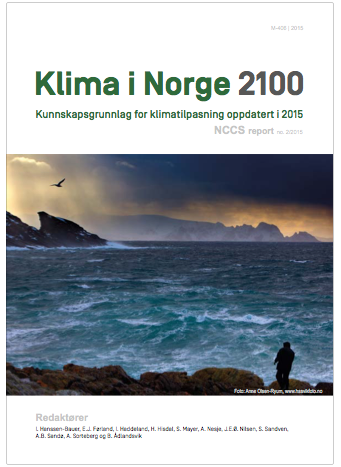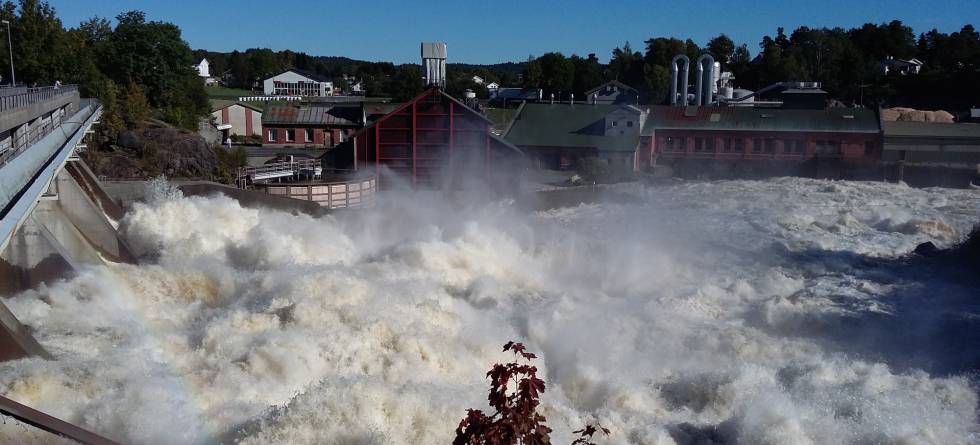By Andreas Graven, Uni Research
Even if emissions in the decades leading up to the year 2100 are cut to 40 percent of 2012 levels, the temperature in Norway will still rise by several degrees on average.
That is one of the findings in the report Klima i Norge 2100 (Climate in Norway 2100) which was published today.

The report was written by the Norwegian Climate Service Centre, which is a collaborative effort between the Norwegian Meteorological Institute, the Norwegian Water Resources and Electricity Directorate (NVE) and Uni Research.
Researcher and meteorologist Stephanie Mayer of Uni Research Climate is one of the main authors of the report:
“The consequences of significantly higher temperatures are more and heavier precipitation, a shorter snow season, rising sea levels and increased melting of Arctic ice,” says Mayer.
The local consequences of heavier precipitation may vary, but the risk of floods, landslides and avalanches may increase substantially, especially in Western Norway.
Knowledge base for adaptation to climate change
Mayer is currently attending the climate adaptation conference in Oslo, where the researchers’ work is being presented. Her daily work is in the research group Climate Dynamics and Climate Service in Uni Research Climate.
This year’s report is an update of the previous report published six years ago, and it constitutes a knowledge base for climate change adaptation in Norway.
“This report has climate models with higher resolution, which gives us more detailed information. That is important in a country like Norway with a long coastline, mountains and fjords,” says Mayer, who also works for the Bjerknes Centre, a partner in climate research.
The researchers have considered two possible scenarios for greenhouse gas emissions until the beginning of the next century.
In one scenario, there is no reduction in emissions, while the more moderate emissions curve means stable, slightly increased emissions until 2040.
“Then there must be a sharp decline in emissions until 2080, to reduce them to 40 percent of the 2012 figure. This must take place while the world population has increased significantly, with the accompanying pressure on food resources,” says Mayer.
Warmer weather either way
Emissions of greenhouse gases such as CO2, CH4 and NO2 will in any case lead to warmer weather in Norway over the coming decades and around the year 2100,” the researchers point out in the new report.
“But an important point is that there are several possible scenarios, depending on cuts in emissions. If we continue as today, Norway will on average be 4.5 degrees warmer by the end of the century. In Northern Norway, the increase will be even greater, at up to six degrees,” says Mayer.
She emphasises that there is always some degree of uncertainty in such estimates, but with the latest IPCC report and more detailed information on local conditions, as a result of the downscaling of climate models, the basis for the estimates is better than ever.
If we manage a sharp cut in emissions, so that the more moderate path is followed, the researchers have calculated a temperature increase of 2.7 degrees.
More days with an average of 20 degrees
Apart from the increase in temperature in general, the number of days defined by the researchers as “hot days” is also expected to increase. That means days where the 24-hour average is 20 degrees or more.
“In Norway today, there are only a very few days like that every year on average in some places. But if emissions are not cut, we could actually see as many as 15 to 25 “hot days” at the turn of the century, especially in Southeastern Norway.
“In the trend that includes reductions in emissions, there could be an increase of 5-10 such days. That will also have consequences, for example for agriculture,” says Mayer.
... and more rain
Another thing is that a higher average temperature will lead to greater annual rainfall,” Mayer points out.
“Higher temperatures will mean increased evaporation over the oceans. Warmer air can hold more water vapour than cold air, so that when it starts to rain, it will rain more. That will increase total rainfall. In the report we have also calculated twice as many days with so-called heavy rainfall, which in western Norway means a lot of water: more than 100 millimetres in one day.
“There are many days in the West when it rains a lot without reaching such huge amounts. The number of ‘days of heavy rainfall’ may increase on average from two to four towards the year 2100. We also see a tendency towards an increased amount of rain on those days,” says Mayer.
The researchers also estimate that the number of days with snow cover (over 5 centimetres) may be reduced by at least two months.
“In the mountains there will be very little change as a result of reduced greenhouse gas emissions, but in the lowlands the snow will in any case arrive later and melt sooner. At least 60 days of the snowy season will be shovelled away, and here in Western Norway there will be very little snow left at lower altitudes,” says Mayer.
Changes must be planned for locally
“The report gives a clear warning that the Norwegian climate up to the year 2100 will be different from the climate we have today.
Download the report here – desktop
Download the report here - mobil

